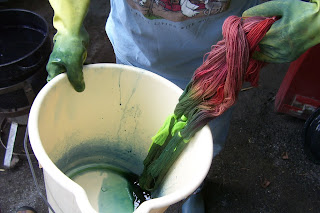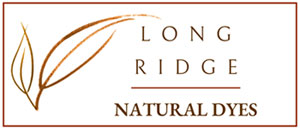I want to share some photos of our annual summer workshops with Michele Wipplinger, founder of Earthues, here at the farm. The weather was just about perfect, albeit summery and warm, but perfect for relaxing around the dye tables.
The first workshop was Painting Variegated Sock Yarns with Earthues Natural Dyes. It was a three day intensive, combining lectures about color theory and the characteristics of the natural dyes, creating color palettes on yarns for the students future reference and then using the color palettes to create skeins on sock yarns. Michele always brings a trunkful of textiles and fibers to stimulate our color senses. We set them out in my studio where the first day she spoke extensively about natural dyeing, fiber preparation and mordanting, Earthues dye properties and the handpainting process using her painted yarns to give example. After lunch we took to the barn to begin the actual work.
Here is Michele in the barn during one of her lectures.
Each student chose their individual dyes from a variety of prepared dye combinations.
With their dye concentrations they then set up yarn cards to test their palettes. These cards are a great reference for the future documentation as well as re-creating a palette. Memory doesn’t always serve us well as time passes! Once the yarn samples are painted and steam set the students organized them on card stock pages with all the information about what dyes, mordants, water (hard vs soft) and any other pertinent facts needed to duplicated the hue again. These yarn samples are ready to be set permanently on card stock.
Her is a student analyzing her yarn samples before she started to paint her first skein. Painting skeins for socks is a system using six or seven colors with a percentage used for dominant, secondary and accent colors within the skein. Each color scheme should have some contrast, just a little: in value, hue or saturation.
An indigo vat is always present in case students want to overdye a portion, the entire skein or merely a strand or two. Here are a couple of the students waiting to dip. They have blocked off areas of the skein that they will not dip in indigo.
This skein has just been pulled from the indigo vat and is ready to let oxidize to get that magical blue only indigo produces.
And a few skeins oxidizing. You can see the puples and greens.


Once again a great workshop exploring the endless options natural dyeing provides.
Special thanks to my friend, Maryann for assisting behind the scenes!

